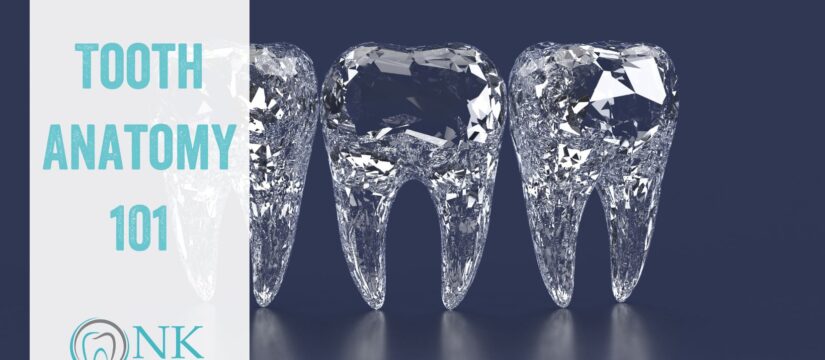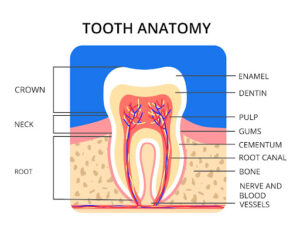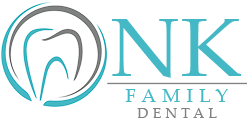
We all have teeth, but what do we really know about them? Most people mainly pay attention to their appearance and their health. Yet beyond that, those who are outside the dental profession are probably unaware of the anatomy, structure, and tissues that comprise our teeth. Although we see the outer surface of our teeth, there’s much more to them than meets the eye! Prepare to learn their secrets, and perhaps gain new respect for these complex structures that are a very important part of you!
First, what exactly is a tooth? Is it a bone, or an organ? Actually, teeth are an ectodermal organ — so-called because they’re located close to the extremity of the body, as are hair, skin, sweat glands, and salivary glands. If you want to impress your friends with your newfound knowledge, mention the fact that, scientifically speaking, bones are also organs!
The Types and Functions of Teeth
One of the points we emphasize to our valued patients at NK Family Dental is that oral health is mutually dependent upon the teeth, gums, and jaws functioning as a complete system. For this reason, we need to look beyond an individual tooth to learn about dentition (the development of teeth and their arrangement in the mouth), and the five types of teeth that make up the permanent set.
Humans have two sets of teeth in their lifetime — primary (baby teeth) and permanent (adult teeth). Adult teeth replace baby teeth between six to 12 years of age. By age 12, most adult teeth should have erupted, except for the third molars, commonly known as wisdom teeth. However, as you may know, all too well, the jawbone of modern humans is often too small to accommodate wisdom teeth, which typically need to be removed. Our blog post — “Long-Term Benefits of Wisdom Teeth Removal” — covers this procedure in detail.
As VC Dental notes, teeth tend to erupt in parallel, so for example, the top molar on the left side should grow at about the same time as the top molar on the right.
A permanent dentition consists of 32 teeth lining the upper and lower jaw, as follows:
- Incisors (eight total) — These are the middlemost four teeth on the upper and lower jaws. They are used for cutting, tearing, and holding food. The biting section of an incisor is wide and thin, making a chisel-shaped cutting edge.
- Canines (four total) — Also known as cuspids – meaning a tooth with a single point – are on either side of the incisors. They are for holding and tearing food.
- Premolars (eight total) — Also known as bicuspids, they have a series of elevations to break up food during chewing. Premolars are only present in the permanent set of teeth.
- Molars (eight total) — These are flat teeth in the rear of the mouth. Each typically has four or five cusps. They are used exclusively for crushing and grinding.
- Third molars (four total) — Also known as wisdom teeth. They can erupt from the age of 18 onward, but as mentioned earlier, are often removed because they become impacted (fail to erupt) or crowd other teeth.
A Tooth From the Outside In
Now that you know each type of tooth, its location in your mouth, and its function, it’s time to look at the tooth itself! We thank MouthHealthy — an oral health information website presented by the American Dental Association (ADA) — for the following information.
Teeth are composed of four dental tissues. Three of them — enamel, dentin, and cementum —are hard tissues. The fourth tissue — pulp, or the center of the tooth that contains nerves, blood vessels, and connective tissue — is a soft, or non-calcified, tissue.

The anatomy of a tooth is as follows:
- Enamel — Hard calcified tissue covering the dentin in the crown of the tooth. Because it contains no living cells, tooth enamel cannot repair damage from decay or from wear. Only a dentist can correct these conditions.
- Anatomical crown — The visible part of your tooth. It is normally covered by enamel.
- Gums (also called gingiva) — Soft tissues that cover and protect the roots of your teeth and cover teeth that have not yet erupted.
- Pulp chamber — The space occupied by the pulp – the soft tissue at the center of your teeth containing nerves, blood vessels, and connective tissue.
- Neck — The area where the crown joins the root.
- Dentin — That part of the tooth that is beneath enamel and cementum. It contains microscopic tubules (small hollow tubes or canals). When dentin loses its protective covering (enamel), the tubules allow heat and cold or acidic, or sticky foods to stimulate the nerves and cells inside the tooth, causing sensitivity.
- Jawbone (alveolar bone) — The part of the jaw that surrounds the roots of the teeth.
- Root canal — The portion of the pulp cavity inside the root of a tooth; the chamber within the root of the tooth that contains the pulp.
- Cementum — Hard connective tissue covering the tooth root, giving attachment to the periodontal ligament.
- Periodontal ligament — A system of collagenous connective tissue fibers that connect the root of a tooth to its socket.
You Depend on Your Teeth, and Your Teeth Depend on You to Keep Them Healthy
Our teeth perform important tasks every day! It’s our responsibility to practice optimum oral care every day — and visit the dentist for twice-yearly examinations and cleanings — so we can keep them for a lifetime! As we always say, good oral health is essential to good overall health.
At NK Family Dental, it is our mission to provide the highest quality and most compassionate oral care to our Chicago patients, including both dental and periodontal services. Our practice is trusted for advanced oral surgery procedures and comfortable root canal treatment.
Our team of experienced, dedicated dental professionals will help address your oral health concerns, and determine the best solution for you based on your individual situation. We strive to identify treatment options that fit your needs.
Our dental specialists include our general dentist, Dr. Nilofer Khan, our endodontist, Dr. Sabek, and our periodontist, Dr. Amir Danesh. Dr. Danesh is a board-certified periodontist and Diplomat of the American Board of Periodontology. He has contributed to the publication of two books, as well as published over 20 papers in prestigious dental research journals.
We serve the neighborhoods of Logan Square, Bucktown, Humboldt Park, and Wicker Park with the dedication that’s earned us the reputation as the Best Dentist in Chicago!
We understand that the main concern you may have is cost, which is why we accept all major PPO plans for dental insurance and also offer our in-house dental plan. Please see our financing page for more information.
Schedule your visit through ZocDoc, or contact us directly. We look forward to treating you soon!
